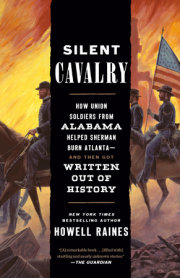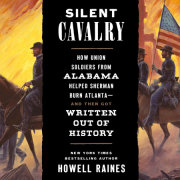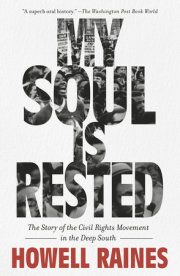1
What Happened to Me at Ma ’n’ Ada’sI was born in Birmingham, Alabama, in 1943, when it was America’s most segregated city. The process by which I came not to believe what most white children of my era were taught about race and the Civil War was a haphazard affair. As a small child I became fascinated with all things rural and ancient, largely as a consequence of visiting my grandparents’ farm in Alabama’s poorest county, a throwback redoubt of Appalachian folkways called the “Free State of Winston.” It was so nicknamed because anti-Secession farmers in the hill country made a legendary attempt to withdraw from Alabama when the state left the Union in 1861. In 1951, Esther Garrett, a tiny, ferociously flamboyant teacher who called herself “Mama Tadpole,” introduced me and the other “Tadpoles” to a glorified version of Alabama history, including the legend of the yellowhammer, our state bird. The black speckles on its tawny breast represented the bullet holes inflicted on Confederate soldiers by the Yankees, Mrs. Garrett explained. The red band on the bird’s neck stood for the blood Alabama boys shed for the southern cause, the yellow on its wings for the flashy scarves the soldiers wore on parade. The imagery was intended to school us in that crude, defiant, fatalistic sangfroid much admired in the Heart of Dixie then and now. Paradoxically, she also taught us to affect a high-toned accent for singing the state song. In the chorus, “Alabama, Alabama, we will aye be true to thee,” we called our state “ah-la-BAH-ma,” the posh enunciation to show we didn’t talk like hillbillies.
The next school year, I fell under the tutelage of the more reserved Telulah Rose Love, a stately matron who was in charge of the school library and presided over the reading list on which our report-card marks were based. Miss Love doted on me and my two older siblings as brighter-than-average kids. I was shaken when I laid my list in front of her and she noted with sadness and surprise that I had read only one book in six weeks. It was Mark Twain’s difficult miscegenation novel, Pudd’nhead Wilson, a didactic condemnation of prejudice based on skin color. To this day I’m amazed that it found its way into a Birmingham public school’s library, given that the state and city boards of education strictly policed our reading materials for signs of excessive sympathy for “Negroes,” “Communists,” or our enemy in the War Between the States. I had plowed through a text that was far beyond my understanding, never quite sure of why one infant was considered Black and another was white. I’m pretty sure Miss Love didn’t know what the book was about either. She just wasn’t going to give an E for “excellent” to a slacker who could finish only one book a month.
Miss Love’s mother was an Owen, and she provided our entrée to the famous woman in Montgomery, the legendary Miss Marie, the widow of Thomas McAdory Owen. Until his untimely death at the age of fifty-three, Tom Owen was a leading figure nationally in higher education. Despite its backwardness in so many fields, Alabama was the first state to establish a state archive to preserve official papers, and as its founder, Dr. Owen hobnobbed with the nation’s top scholars at American Historical Association conventions in Manhattan and New Orleans. He had also been the national historian-general of the Sons of Confederate Veterans and an energetic promoter of the Lost Cause school of Civil War scholarship among American historians. Newly widowed in 1920, Miss Marie used her political connections to secure what she called her “meal ticket.” Since Marie Bankhead Owen’s father was a longtime senator from Alabama, and her brother William B. Bankhead was the Speaker of the House of Representatives, FDR had given her a New Deal grant to construct the archives building as an imposing alabaster shrine to her late husband. She was named only a week after his death to succeed her husband as director of the Alabama Department of Archives and History.
She reigned there for over three decades as the guardian of his memory and administrator of the gleaming museum of all things touching on the Old South and Confederate glory. Her tigerish reputation among legislators arose from the fact that, in her officerships in the Daughters of the American Revolution, the United Daughters of the Confederacy, the Alabama Library Association, and the Women’s Christian Temperance Union, she could flood the halls of the capitol with women supporting any cause she considered sufficiently genteel and conservative. Thanks to the Owen connection, Miss Love was able to lead my fourth-grade class on a field trip to the archives. I remember that Miss Marie radiated the certitude of power and virtue as my classmates and I clustered around her in the high-ceilinged Hall of Flags while she explained the holiness of the bullet holes in the large Rebel battle flag framed on the wall behind her.
Childhood memory is wavery in some spots and crystal clear in others. My mental image of Miss Marie on that long-ago day in Montgomery is of the latter type. She looked to me like pictures I’d seen of Queen Victoria. But I think I must have garbled some of the lore we heard that day about the flag mounted on the wall behind her. For years, I believed Miss Marie had told us this was the flag of truce under which Lee surrendered at Appomattox. But it turned out that the actual fabric surrendered that time was a white dinner napkin carried by Captain Thomas Goode Jones, a Bourbon Democrat and future governor who helped get white supremacy written into Alabama’s 1901 constitution. In looking back, I’ve speculated that Miss Marie may have mentioned that Governor Jones was the father of one of her Montgomery courtiers, a judge and a part-time journalist named Walter B. Jones. The judge, an eccentric who devoted his Sunday newspaper column to Confederate boasting and the defense of segregation, had his fifteen minutes of national fame in 1964. As presiding judge in the landmark libel case Times v. Sullivan, he lectured lawyers for my future newspaper on the uses of “white man’s justice” in dealing with “racial agitators.” Judge Jones also took pen in hand in 1934 to condemn a bestselling book entitled Stars Fell on Alabama, whose foreword thanked Marie Bankhead Owen by name.
All these names will recur in my narrative, and I mention them here by way of observing that Alabama is somewhat similar to Flannery O’Connor’s Georgia; there everything that rises must converge. The late Alabama folklorist Kathryn Tucker Windham said Alabama is “one big front porch,” and life on that porch is more horizontal; everything circles, overlaps, and sooner or later seems to connect. In his 1934 review of Stars Fell on Alabama, the book that taught me to see Alabama in its magisterial perversity, the influential New Yorker critic Clifton Fadiman dismissively referred to “the native tribes of Alabama,” but it was among these presumed primitives that my subversive reflections and my education as a contrarian began. And it’s hard to imagine a better family for an inquisitive child to be born to than mine.
Reconstructing my political education at the family hearth is like following a trail of crumbs that can be traced more clearly now than was the case in the beginning, the presidential election year of 1948. On November 2 of that year, I stood at the top of the porch steps of my grandmother’s house, a five-year-old watching my parents climb from our maroon Chrysler sedan and start up the sidewalk. They were dressed as if for church or business. My father, a partner with his two brothers in a decade-old business that made store fixtures for the A&P grocery chain, then spreading across Alabama, held aloft two fingers and called out to me and my two sitters, my grandmother and my maiden aunt Ada, “Two for Dewey.”
I had no way of knowing how much his words told about Alabama and our family. In political terms, forty-one-year-old Wattie Simeon Raines and his wife, Bertha Estelle Walker Raines, also forty-one, were returning to the family fold by voting for the Republican presidential nominee, Thomas E. Dewey, who would lose to FDR by a landslide. As struggling newlyweds living in small-town Alabama they bolted to the Democrats and voted for FDR in 1932 and in the next two elections. By 1948, with their family of five ensconced in the modern bungalow they built in 1937 in a rising neighborhood in Birmingham, they were city folk who could afford to become Republicans—again. Only a demographer with a good grasp of Alabama’s Civil War history could have understood that the Raines and Walker families were, as hereditary white Republicans, rara avises in the corrupt Alabama political jungle ruled by yellow dog Democrats.
Copyright © 2023 by Howell Raines. All rights reserved. No part of this excerpt may be reproduced or reprinted without permission in writing from the publisher.







